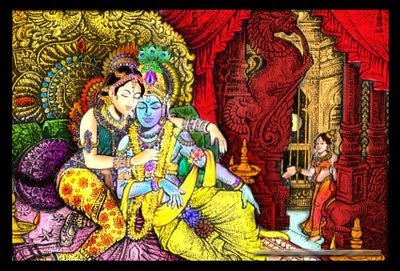The Divine Concept
Nappinnai enjoys an exalted position in Tamil religious literature, similar to that of Lakshmi, the consort of the Lord. In fact, the azhwar tradition has given the highest pedestral to Nappinnai amongst the three beloveds of the Lord, the other two being Sri and Bhu. Andal, the only lady saint refers to her supreme status, as the sole recipient of the unbounded love of Lord Krishna. In her Thiruppavai, Andal refers to Nappinnai in three verses, the first of them being the favourite of Sri Ramanuja. Hence, the later acharyas interpreted this stanza as, ‘the damsels of Gokulam, having failed to wake up the Lord from his slumber, appeal to Nappinnai in the characteristic Srivaishnava concept of securing recommendatory help, Purushakaratva from her. Nappinnai has beautiful locks of hair emitting fragrance’. The girls of Gokulam appeal to her thus: “Oh! Pure one! Our worshipful Nappinnai, are you not Thiru (Lakshmi) herself? Get up from sleep” (pasuram19). Nappinnai is implored to wake so that she might awaken the Lord.
The earliest reference to the three consorts of Sri Vishnu could be traced to Poigaiazhwar, who conceives them as Tirumakal, Manmakal and Aymakal, being respectively Sri, Bhu and Nappinnai (cowherd gril). Later, Aymakal came to be represented as Nila, as exemplified by Parasara Bhatta in his famous dedicatory stanza (taniyan) in Sanskrit, which commences with, “Nilatungastanagiritati…”, etc. The Srivaishnava tradition has recognised Nappinnai as Nila. The first clear reference to this can be had from Ramanuja’s Gadyatraya and Nityagrantha, wherein he extols the Lord as Sri-Bhu-Nilasameta. Thus, the concept of Nappinnai in Tamil and as Nila in Sanskrit has come to occupy a unique place of reverence and compassion in religious literature.
Interpretations of the Name
The meaning of the word Nappinnai can be derived in two way: (1) nam+pinnai, meaning, ‘our mother’s sister’ or ‘foster mother’. This derivation signifies that Nappinnai is accorded a place next to Lakshmi, as the second universal mother. In Tamil tradition, Nappinnai is sometimes given even greater importance than Rukmini or Satyabhama, in the matter of being the recipient of the boundless love of Lord Krishna. The second derivation is based on na + pinnai, wherein ‘na’ denotes something great or unique and pinnai, meaning locks of hair, the whole word meaning, ‘the one with beautiful locks of hair’.
Literary Allusions
Various Tamil writers from the early centuries of this era, extol Nappinnai as the loveliest of all the damsels that Krishna married. Translations of a few select verses are provided hereunder, in support, from the collected works of M. Raghava Iyengar.
‘Nappinnai, with the beautiful bangles, who adorns the chest of the Lord, who measured the Earth’ – Silappatikaram, 17.
‘The consort of the Lord of the earth and the one who drank the nectar of the mouth of Nappinnai’ – Chintamani
‘The one who married the beautiful Nappinnai’ – Thirukkovaiyar (18.8)
‘The one who subdued the seven fierce bulls for the sake of marrying the blemishless and beautiful Nappinnai’ – Thiruvaimozhi (4.8.4)
It would be observed from the above, that Tamil writers had a true perspective of the nature and glory of Nappinnai and have sung in memorable lines, on the beauty of her form and the exalted place she holds as the chosen consort of Sri Krishna in Gokulam.
By KKA Venkatachari
Source: NrisimhaPriya, 2004











Very informative
is nappinnai is srimathi radharani who is the chosen cosort of Sri Krishna in Gokulam?
No, Srimati Radhika is Devi Lakshmi. Nappinnai is Niladevi [Form of Devi Lakshmi]. Both have 1 soul but different bodies on earth.